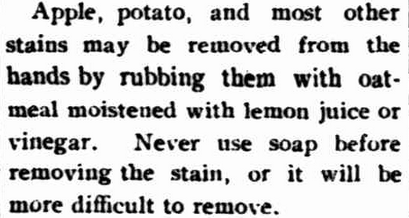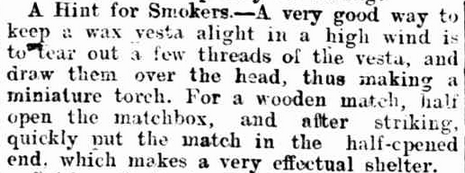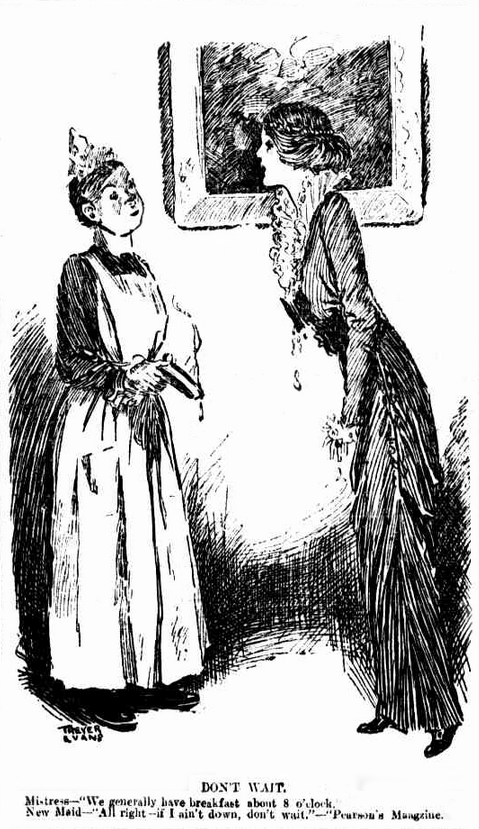Historical newspapers are a treasure trove of information about the ways people lived in the past. The Wanted Ads can provide us with information about everything from the types of jobs on offer, the people offering services, the range of accommodation, and the wide variety of goods traded and sold, not to mention the infinite preferences of those seeking a spouse. As well, from the 1860s on, newspapers started to regularly print columns of household hints. These clearly illustrate the frugality of people in the past, as well as their inventiveness. For many keeping household goods in good repair and extending their life was out of necessity.
I have previously posted a collections of newpaper hints concerned with keep both clothing and the person presentable. This month’s collection shows the myriad ways people tried to ensure that nothing was wasted—clothing and household objects were mended, stains were removed, and when items had reached the end of their useful life, they were often recycled.

Waste not, want not
Even when household items were worn out or practically used up, there were ways to still get some use from them.
Woollen stockings when too old for wear are exceedingly useful for cleaning purposes. The tops should be cut off and sewn together until sufficiently thick. Remnants of flannel and woollen materials may be utilised in this same way, and make very good interlinings for iron and kettle holders. — Petersburg Times Fri 18 Dec 1896 p.2

Do not throw away ends of candles, but save them for fire lighters. One placed in the middle of the coal and sticks when the fire is laid will cause it to burn immediately. — The Ballan Times Thu 12 Jun 1919 p.1


In the Laundry
Stain removal was one way of extending the life of items, particularly clothing. It seems to be a perennial problem given the number of books on the topic and magic cleaning potions on supermarket shelves.
To remove wet ink stains rub with a piece of ripe tomato and then rinse well in cold water. Wash and boil, or put a little red ink on the mark and wash. The acid dissolves the iron in the ink and sets free the tannin or coloring matter, which will boil out. — The Colac Herald Wed 2 Feb 1916 p.3
Stained hands were also a problem, though I wasn’t aware that apple and potato stained the skin. I wonder if this would work on stains caused by indelible ink or stove blacking.

And if the soap had run out, some interesting alternatives were near at hand.
A Substitute for Soap – Boiled potatoes make an excellent substitute for soap when the hands have become blackened by contact with pots and pans. Rub a little of the potato well into the hands and wash in warm water. — The Sydney Wool and Stock Journal Fri 22 Mar 1912 p.14

An ounce of prevention
A number of hints pointed to ways of ensuring that household items did not become damaged or wear out quickly.

Darling Downs Gazette Mon 16 May 1910 p.7
With open fires, candles and paraffin lamps in use, there was the danger of clothing catching fire which would have serious consequences for the wearer as well.
To render garments non-inflammable rinse them in alum water. It is a good plan to do this with all the children’s clothes. — Nor-West Echo Sat 10 Apr 1915 p.2
Frugality even extended as far as making sure that matches were not wasted.

Matches can be made proof against dampness by dipping them in very hot melted paraffin. — The Colac Herald Wed 2 Feb 1916 p.3
As rusty needles and pins could stain the cloth they were used on, and so spoil the joy of a new shirt or dress, this is useful advice.


In the kitchen
Even the life of some foodstuffs could be extended. Though, while milk on the turn might work well when cooked, I don’t know that I’d want it in tea or on my cereal, even if the sour taste had gone.
Milk which is slightly turned or changed may be sweetened or rendered fit for use again by stirring in a little soda.
Stale buns may be made to taste as nicely as when fresh if they are dipped for a moment or so in cold water, then put in a hot oven for five or ten minutes. They will turn out as light and crisp as when first baked. — The Week Sat 14 May 1887 p.27

Circular Head Chronicle Wed 17 Sep 1919 p.4
Sour milk can be made into fritters. Mix two breakfast cupfuls of flour, to which half a teaspoonful of baking powder has been added, with sufficient sour milk to form a batter, and fry a teaspoonful at a time in hot fat. These can be eaten at breakfast or supper, and effect an economy in bread. — Nor-West Echo Sat 10 Apr 1915 p.2

In my next post of household hints, I will share two types of recipes, those for the control of household pests, and also the more conventional culinary recipes including a supposedly appealing way to serve the high point of a meal.

______________________________________________________________________
All the advertisements and their images can be found using the invaluable Trove search portal of the National Library of Australia.
There now seems to be a revival in repairing and restoring that was getting forgotten and pushed aside by commercial interests who wanted to grow their bottom line and sell you a new replacement. I’m not sure how it will pan out with miniturisation though.
LikeLike
Wonderful Post, Catherine.
LikeLiked by 1 person